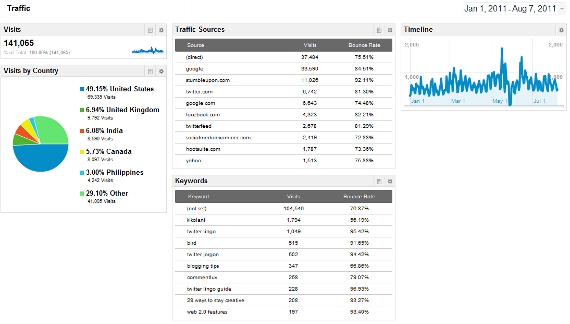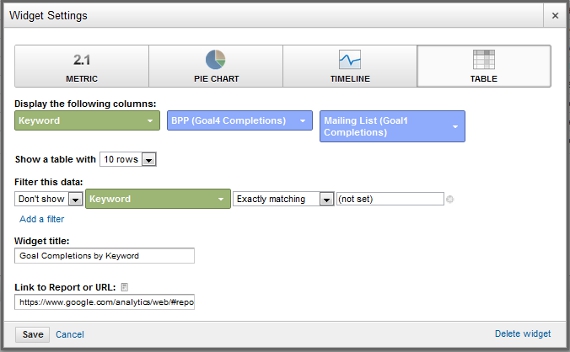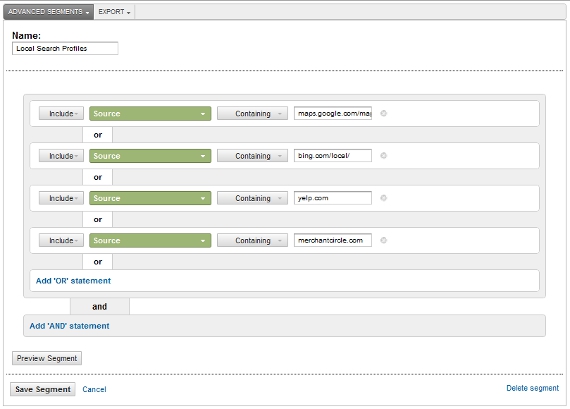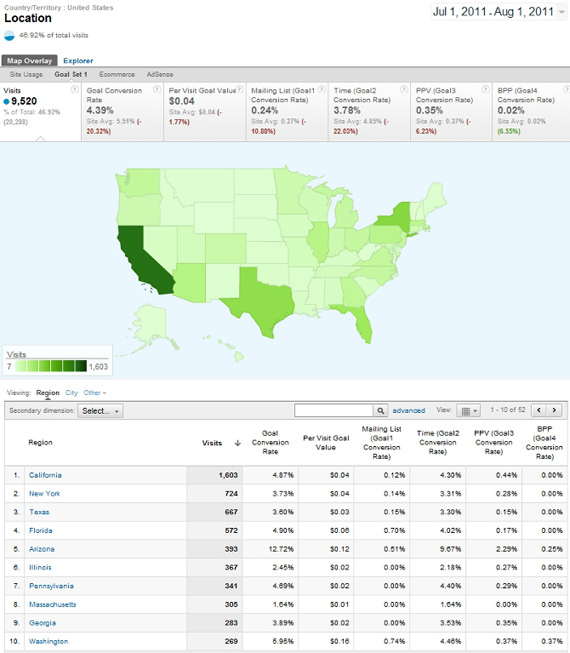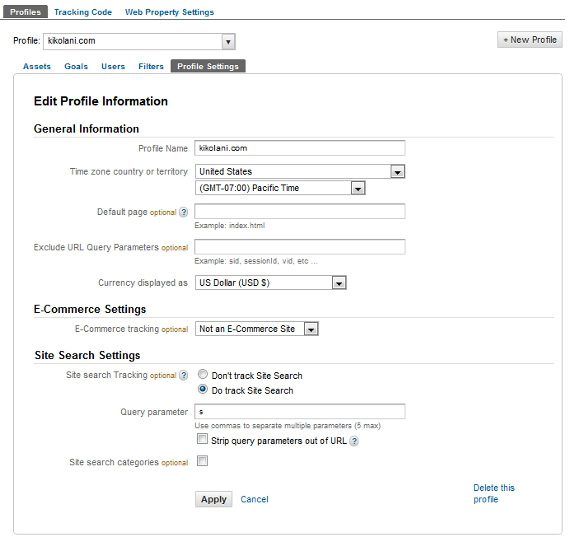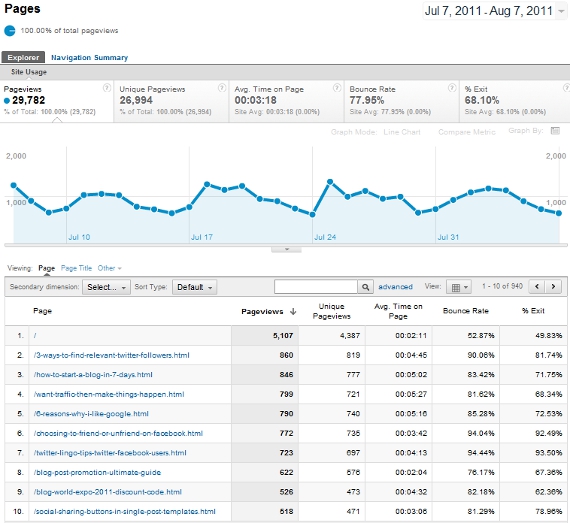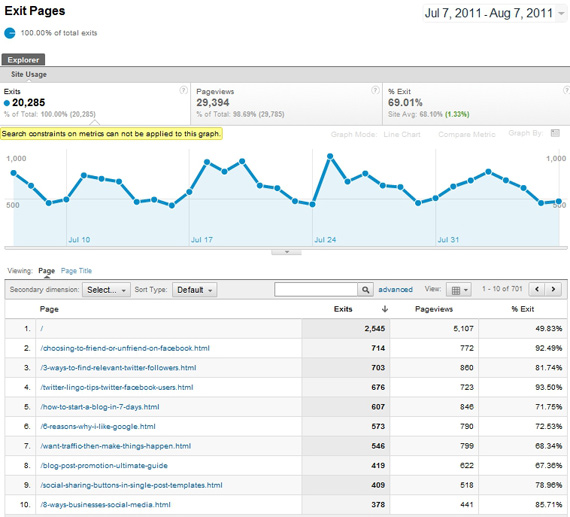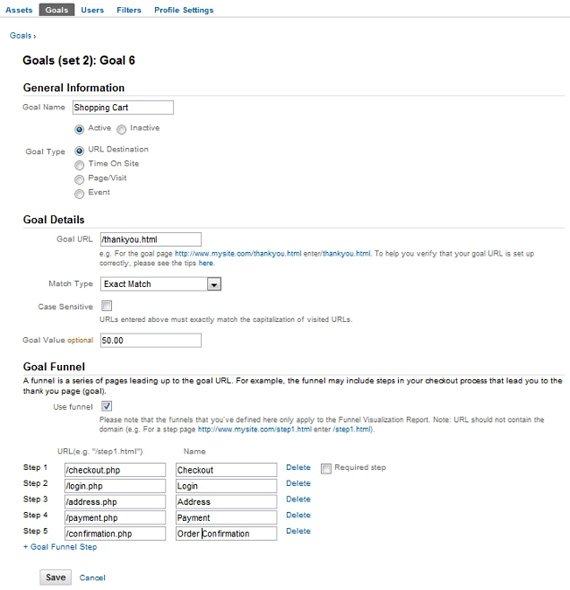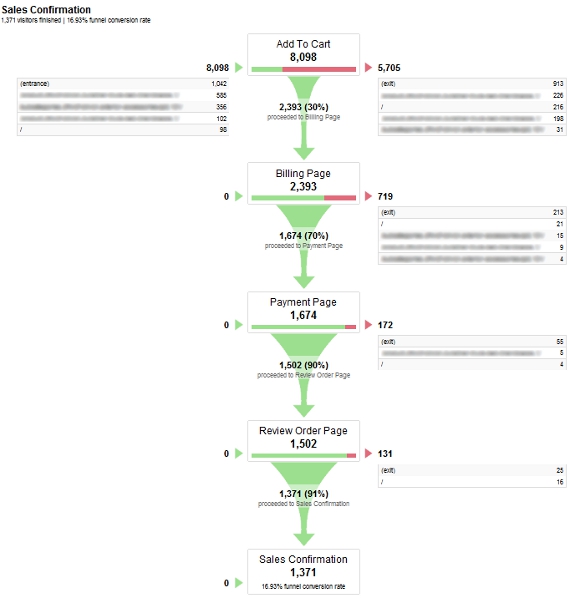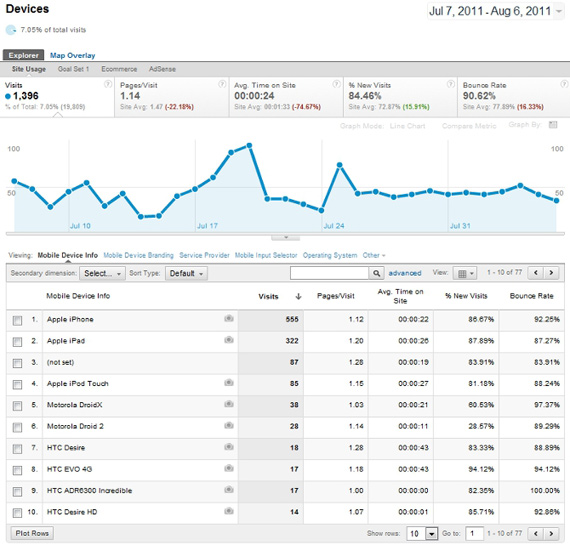Hi I am Virat Parikh.
What is the first
thing you want when you think about web analytics?
Tools!
Of course tools.
What to do, where to start, what's cool.
I was reflecting on that recently and thought it was incredible that in
all my years of writing this blog I have never written a blog post, not one
single one (!!), recommending tools for the complete web analytics 2.0 spectrum.
Well that ends today.
My goal is to give you a list of tools that I use in my everyday life as
a practitioner (you'll see many of them implemented on this blog). You are not
going to use all of them all at the same time (or with every client), but 1. it
is good to know what is out there and 2. to be awesome you are likely to use
one from each category.
[Disclosure:] I am the co-Founder of Market Motive Inc and the Analytics Evangelist
for Google. I do not have
financial or equity or any other stake in any company mentioned in this blog
post (except Google). None of these tools vendors have any relationship with
Market Motive either. They are on this list because IMHO they provide value and
are better than their competition. [/Disclosure]
Before we jump into tools a few key bits of context, after all context is queen!
First Bit Of Context.
. . Web Analytics 2.0.
This blog post is
about web analytics 2.0. Not just clickstream analysis.
As defined in my
second book Web Analytics 2.0 is:
1. the analysis of qualitative and quantitative data from your website
and the competition,
2. to drive a continual improvement of the online experience of your
customers and prospects,
3. which translates into your desired outcomes (online and offline)
An expansive view of what it means to use data online, both from the
type of data perspective and the kind of desired impact perspective.
Second Bit Of Context.
. . Multiplicity.
Given the
definition above, I am a firm believer in Multiplicity.
Every single company, regardless of size, will require multiple tools to
understand the performance of its website, happiness of its customers and glean
key context from competitors and ecosystem evolution.
The quest for a
"single source of the truth" on the web is futile.
Actually let me rephrase that. . . the quest for a single tool/source to
answer all your questions will ensure that your business will end up in a
ditch, and additionally ensure that your career (from the Analyst to the web
CMO) will be short-lived.
Sorry.
You should know upfront that you are going to fail, often spectacularly,
if you don't embrace the fact that you have many complicated questions to
answer, from many different sources.
To be an Analysis Ninja, and part of a successful web business,
embrace Web Analytics 2.0 and embrace
Multiplicity. Use a clickstream source when you have to, switch to testing to
move beyond HiPPO's and inferences from click data, invite customers on a
regular basis share feedback with you using surveys and usability, and poke and
prod your competitor's and ecosystem performance to know what to do more of and
what to do less of and what you have been blind to.
Do that. Work hard. Win big. Rinse, repeat.
Third Bit Of Context.
. . Don't Be Scared: Prioritize.
Many people get
really scared and run for the hills when they first put Web Analytics 2.0 and
Multiplicity together.
Don't be.
Depending on the size of your company (translation: resources available
and what's impactful and doable) here is the priority order that I recommend
for you to execute your web analytics tools strategy right. . .
Not everybody should do everything in the same order. In my humble
experience the above order works best for small, medium and large sized
companies.
The result of going in a specific order is that this does not have to
all be done overnight. You can take your time and evolve over time.
For more on why I recommend this specific order please see my second
book, Web Analytics 2.0, which many of you already have.
Fourth Bit Of Context.
. . The 10/90 Rule!
I can't ever talk about tools without reminding you of my 10/90 rule for magnificent success in web analytics.
First presented at an eMetrics summit in 2005 the 10/90 rule was borne
out of my observations of why most companies fail miserably at web analytics.
Put simply it states:
Summary: Its the
people.
You may not go with precisely 90, that is ok. But overinvest in people
and everything that is required to make those people successful: invest in
process, invest in their training, invest in large monitors for them, invest in
backing them up against senior management, invest in involving them in key
business strategy meetings, invest in… you catch my drift).
The coolest tools, the really expensive tools, will deliver diddly squat
for your business. They'll simply puke data faster and, if you implement them
right, more efficiently.
It's your investment in the 90 that will deliver glory.
People matter.
With those minor caveats, and what it takes to be successful refreshers,
I am really excited to tell you all about tools!
: )
The
Best Web Analytics 2.0 Tools For Maximum Awesomeness!
Let us break this list into the components of Web Analytics 2.0 so you
have some reference as to where each item fits (and this will also make it
easier for you to pick tools for the priority order referenced in Context #3
above).
Clickstream
Analysis Tools [The "What"]
To many people the clickstream world is all there is to the web
analytics world. It is without a doubt the largest source of data you'll
access.
There are hundreds (I kid you not) of clickstream tools, I recommend you
keep your life on the straight and narrow and pick one, just one (!), of these
three tools:
~ Yahoo! Web Analytics
~ Google Analytics
~ Piwik
Yahoo! and Google provide world class web analytics tools for free.
Custom reporting, advanced segmentation, advanced rich media tracking,
auto-integration with search engine PPC campaigns, advanced mathematical
intelligence, algorithmic data sorting options, complete ecommerce tracking,
super scalable sophisticated data capture methods such as custom variables,
open free and full API access to the data, loads and loads and loads of
developer applications to do cool data visualizations, data transformations,
external data integrations and more. I am forgetting the other 25 features
these tools provide for free.
Additionally if you look at the massive progress these two tools have
made in the last 24 months there is hardly anything, more like _nothing_, they
can't do that other vendors, free or paid, can do.
There would have to be an overwhelming preponderance of evidence showing
that your company is magnificently unique, extremely special and with such
incredibly uncommon needs that you need to go with any other clickstream tool
(including paid clickstream tools from Omniture, CoreMetrics, Unica, WebTrends
or anyone else).
If you have never done web analysis, start with one of these two.
If you have always done analysis and only use clickstream tools like
Site Catalyst or Coremetrics Analytics or WebTrends Analytics then switch to
one of these two tools and invest the money in Analysts (and wait just a couple
months for your mind to be blown by valuable insights).
This is not to say paid web analytics tools (that do more than just
clickstream analysis) don't provide value.
If after rigorous analysis you have determined that you have evolved to
a stage that you need a data warehouse then you are out of luck with Yahoo! and
Google, get a paid solution. If you can show ROI on a DW it would be a good use
of your money to go with Omniture Discover, WebTrends Data Mart, Coremetrics
Explore.
If you have evolved to a stage that you need behavior targeting then get
Omniture Test and Target or Sitespect. Good use of your money.
Spending money on the base solutions from paid vendors is a very poor
use of your money.
IMPORTANT: Many people think it is hard to get the free Yahoo! Web
Analytics. Not true. There are three specific ways to get Yahoo! Web
Analytics. Read this: How do I get a Yahoo! Web Analytics account?
If you are technically oriented, don't trust either Yahoo! or Google and
up for an adventure I highly recommend you consider using Piwik.
It is a wonderful solution. It has been constantly updated in the two
years I have watched it. Piwik provides you plenty of capability to explore
your inner technical unicorn while allowing you to answer business questions.
Three tools. Pick one. Move on with your analytical lives. Move from a
data collection obsession and develop a crush on data analysts.
Special Recommendations:
~ Feedburner
Any website that provides an RSS feed would do very well to use
Feedburner.
There is a lot of clickstream activity that is happening inside your RSS
feed (and away from your website). Without Feedburner you have zero insights
into that behaviour of your most precious customers, those who are pulling your
site/blog/marketing without you having to hound them.
~ Percent Mobile
Most web analytics tools (including all the ones mentioned above)
provide not great data about consumption of your website on mobile devices. By
default they only work with JavaScript tags (Percent Mobile will also capture
behavior on non JavaScript enabled phones) and even then their databases of
phone attributes and carrier attributes are quite poor.
So if you want really good mobile behaviour data (in a separate but
useful silo) then go get Percent Mobile. There is a free starter edition if you just want to play with it.
~ Google Webmaster Tools / Bing Webmaster Tools
Most web analysts are not responsible for SEO Analytics, and it is such a shame. A huge vast majority of clicks coming from
search engines continue to be organic clicks (which is why I love and adore
search engine optimization).
Any web analytics on your site will tell you how many clicks came to you
from a search engine. But do you know your organic impression share for your
top keywords? You can only get that from Webmaster tools (I know, I know, it
would look really good in Google Analytics!).
Besides that to me SEO is an important part of marketing. I consider it
my business as a web analyst, to report on how well the site is being indexed,
keywords it is showing up for (but not getting clicks for), changes in trends
for impression share and clicks on search engines (via the brand spanking new
Google Webmaster Tools report) etc. I consider that to be web analytics.
You may not. But I believe you'll do your company a great service if you
do, and now you know where to go to get started. :)
Outcomes Analysis Tools
[The "How Much"]
Most outcomes analysis you will do in identifying your macro and micro conversions (for profit or non profit sites, government or ecommerce) will happen inside other tools mentioned in this
blog post.
For example you'll configure goals and ecommerce tracking in Yahoo! Web
Analytics or Google Analytics or Piwik. You'll measure Task Completion
Rate in 4Q (below). You'll measure Share of Search using Insights for Search
(below).
Or, if you truly want my admiration, you'll compute Profit and Margin
for your campaigns in Microsoft Excel or using the most relevant database
query.
So no specific tools recommendation here. Only a plea to obsessively
obsess about measuring outcomes and compute economic value, not just revenue.
[See Quantifying Economic Value on page 159 of Web Analytics 2.0.]
Special Recommendations:
I'll make two types of multi-channel analytics outcomes recommendations here.
If you have a phone number on your site then you would be very
well-advised to implement a phone call tracking solution on your website.
~ Mongoose Metrics
~ ifbyphone
I know Mongoose Metrics a bit more and have been impressed with their
solution and evolution over the last couple of years. My trusted friends have
been equally impressed with ifbyphone.
It is pretty easy to integrate phone outcomes data with your web
analytics solution. See this video by ifbyphone: Google Analytics Phone Call Integration or this page
on the MongooseMetrics site: AccuTrack. These solutions
also integrate with other web analytics tools.
If you spend any
decent amount of money on email, search or display campaigns and have a phone
call option then it is pretty criminal not to use one of these guys to get a
really good understanding of offline conversions. Without them you might be
missing such an important part of the "what have we actually accomplished
on our website" equation.
~ LivePerson
If you offer a live chat option on your website then outcomes can also
be measured in a lovely manner using the LivePerson solution. With simple
configuration updates in the tools you'll create a custom report showing you
Source/Campaign, Visits –> Live Chat % –> Goal Conversion Rate –> Per
Visit Goal Value.
Sweetness.
Experimentation
and Testing Tools [The "Why" – Part 1]
I firmly believe that God created the internet so we could fail faster.
I know of no other way to achieve one's global maxima on the web.
The fact that this is a great way to prove HiPPOs right or wrong is a
bonus. The fact that this is perhaps the most amazing way to get your customers
involved in creating win-win offers/content/experiences/outcomes is the cherry
on top of the bonus.
~ Google Website Optimizer
GWO is free (you don't have to use AdWords or Google Analytics to use
it) and is perhaps all you need as a robust A/B and Multivariate (MVT) testing
solution.
Here's a free guide – 26 pages – to use the website optimizer optimally:
PDF Download: The Techie Guide to Google Website Optimizer.
If you need ideas of what to test: Experiment or Die. Five Reasons And Awesome Testing Ideas.
No serious web analytics program in any company is complete without
robust and persistent testing. None. Not a single one.
Special Recommendation:
~ Optimizely
If you want to jump
into testing very very fast and start doing A/B testing tonight (I am not
kidding: tonight!) then I recommend using Optimizely.
Slight amount of technical knowledge will be a plus, but it is really
really easy to get started. Just go to their site and type in your URL in the
blue box and hit the green button and you'll see what I am talking about.
You'll be setting up you A/B test in 5 mins.
They even have a Platinum support
plan where you get the CEO's direct cell phone number! How can you not
totally love that? : )
~ AdWords Campaign Experiments by Google
I wish I could put
into words how much I love ACE (AdWords Campaign Experiments). It is truly a
blessing for anyone that does paid search marketing.
So many companies
large and small truly suck at doing AdWords properly. And it does not matter if
they use a large brand name Agency. This sucking can be solved immediately and
awesomely by using ACE.
Adgroups and match
types and content and copy and URLs and keywords and negatives and positives
and bid prices and so many levers to pull to improve Impressions, CTRs and ROI
of your AdWords campaigns.
Now you don't have
to do the super lame before and after “experiments”, you can do true test and
control experiments and learn how to win, and win big, at this AdWords thing
you are spending so much (or so little) money on.
I hate to be a
bearer of bad news but if your company or Agency is not using ACE every day to
make you a ton more money, then fire someone.
Here's all you need
to know about ACE: AdWords Campaign Experiments Videos & Guides.
Voice of Customer Tools
[The "Why" – Part 2]
It is quite incorrect
to believe that by analyzing the clicks of visitors to your website that you
suddently have an ability to capture "voice of customer". That would
be like trying to talk to your mom while holding a banana to your ear instead
of a telephone.
I have been
profoundly humbled by how much one can learn by using qualitative methods to
collect VOC.
Of the hundreds
of online survey providers out there, here are two of my
current favorites:
~ 4Q by iPerceptions
~ KissInsights
I am extremely
biased towards sensible short surveys, versus many people's preferred option of
a 42 question puke "survey". I have come to realize that asking
just a few right questions translates into a respect for the website visitor's
time, an extreme focus at your end, and, blessedly, action by your company
based on VOC.
4Q is a "site level survey." By default you ask just four questions
(though you can add two more optional questions) when people exit your site. It
provides the Key Performance Indicator that I consider to be the holiest of the
holy in web analytics: Task Completion Rate (segmented by Primary Purpose).
If you want to see
how 4Q looks and works click here.
KissInsights is a "page level survey." You ask one question (how can you not love
that!) and have an ability to get a yes, no or open text answer. The survey
invite is unobtrusive. You can control the amount of time spent on a page
before the survey shows up, you can add conditional logic, and so much more, to
the survey invitation process.
If you want to see how Kissinsights works just go to site and customize your own in a few
seconds.
Both 4Q and
KissInsights come with free starter solutions. Both are available in multiple
languages. Each solves a different problem, and solves it very well.
Another great way to collect voice of customer (VOC) is to do usability
studies. A recent sweet development is that you don't just have to rely on
often expensive lab usability
studies. You can conduct affordable, scalable and frequent online usability
studies.
~ UserTesting.com
~ Loop11.com
For $39 a pop UserTesting.com allows you to specify the demographic and
other attributes of the users you are most interested in and then have those
users complete tasks you specify on your site. You get a video and a written
summary of their experiences. Nothing more powerful than actual frustrated
users right?
Loop11 is different
in several small ways but the primary difference is that you pay a flat fee of
$350 for each study while allows you to have to 1,000 participants and
unlimited number of tasks. You are also in control of study participants and
you can invite them via social media or a pop up on your site.
They also have a
sweet demo, check it out here: Loop11 Participant
Demo. The demo is a sweet way to convince your boss to give you money for a
usability study (with either company! :)).
Finally one last
VOC recommendation, this one very tactical and focused on single page
optimization (vs. site and experience optimization with the voc tools outlined
above).
Reference link as under:
